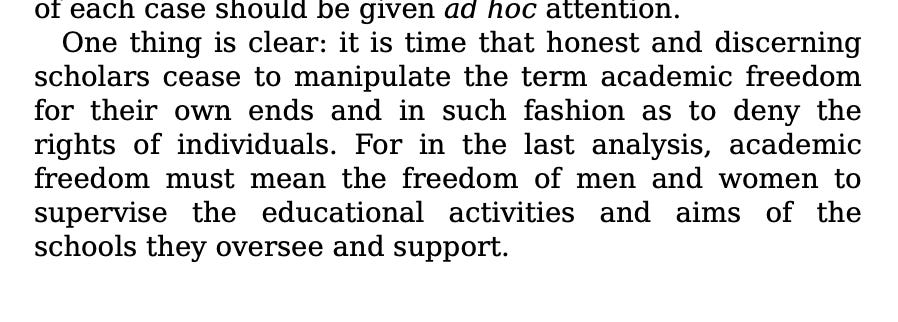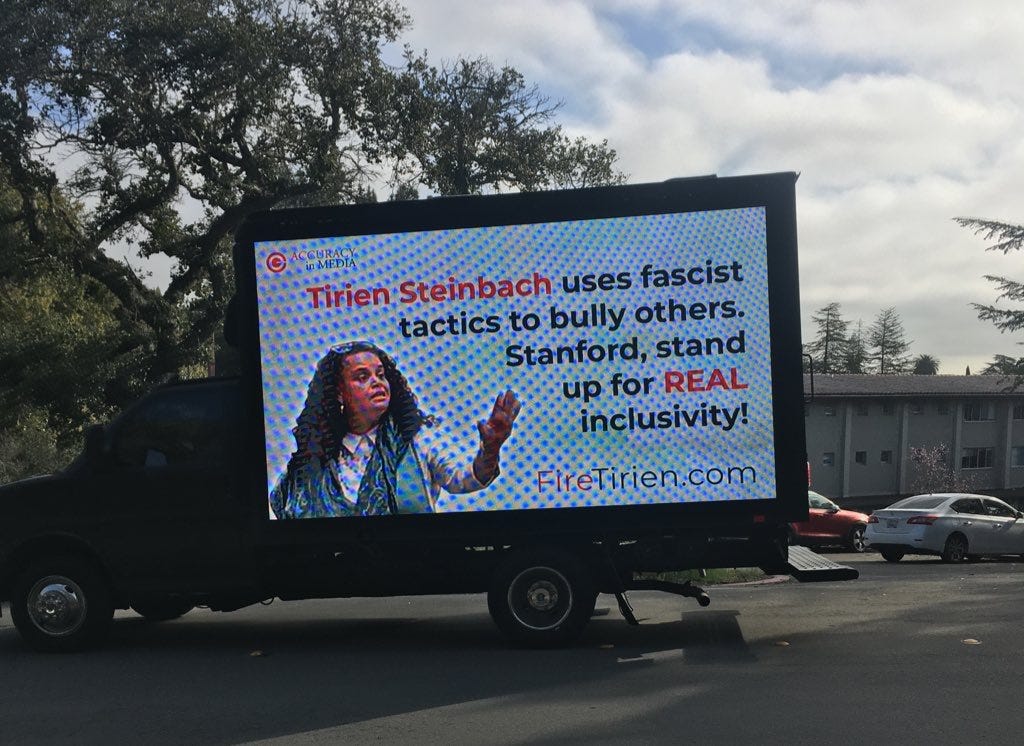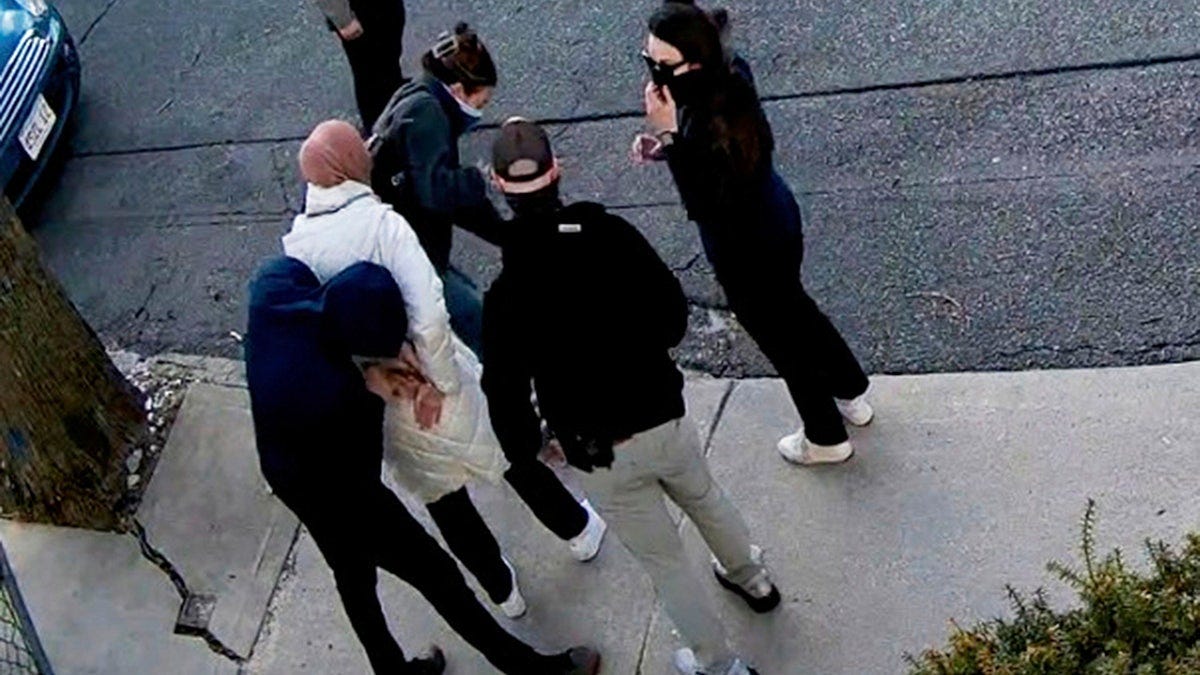A few observations on the assault on higher education
State Anti-Intellectualism meets Libertarian Authoritarianism
These are extraordinary times in higher education, and I keep getting asked about them. Our students and colleagues are being whisked away off the streets and at the airport, our tenure protections are being shredded, our universities reorganized, our funding cut. I want to provide some of my own thoughts, and collect some points that have helped me to make sense of what is happening. I’ll keep this brief, as I’ve been writing about this for various outlets, but I think a few points are worth emphasizing beyond what I have been able to do elsewhere.
(1) A first simple point: wow, are we talking about Columbia and Harvard a lot! Again! There’s good reason for this, of course: the media, business and political elites attacking higher ed are obsessed with these universities — either they went there, or they didn’t get in, and someone else got in, which is worse. As I’ll argue below, the attack on the big, famous R1 universities is a spectacle, and it responds to a logic of spectacle. Columbia had the big solidarity encampment; so did Cal Poly Humboldt. But Cal Poly Humboldt isn’t a school that many New York Times writers have alumni connections to, Cal Poly Humboldt doesn’t have wealthy donors who talk to the Times’s financial reporters, and Cal Poly Humboldt isn’t just a subway or an Acela ride away. So Columbia got the attention, and that attention now brings with it the crackdown. The crackdown follows the grooves and patterns of media attention.
That doesn’t mean that universities that aren’t Harvard or Columbia are not affected. But it means that we’re paying way less attention when they are. Even when the developments are functionally the same, the old unspoken rules of “THE CAMPUS” hold. When a University of Alabama student disappeared, it was worth a lot less attention than when a student at Tufts did. Over the last few weeks, states like Texas and Ohio have geared up to remove tenure protections, to put public universities under the control of boards of governors (meaning essentially donors as well as business and political elites — many of these boards do have student members, but they’re non-voting), with governors or trustees in charge of hiring and disciplining students and faculties. It’s what the administration demanded of Columbia, but on steroids. And yet our eyes are, once again, glued to the big campuses everyone’s heard of.
(2) When it comes to the big, famous private universities: As I argue in this piece for Germany’s Der Spiegel, it is important to note that the impression that this is about the feds on one side and “the university” on the other, is mistaken. Consider the sequence of events at Columbia University: when the government cut 400 million dollars in federal funding, a tense negotiation ensued, and it quickly emerged that Columbia would cave. But the place where it emerged was pretty interesting: the New York Times has been obsessed with events at Columbia, and its reporters seem to have been swarming the campus for months to get good quotes and report on even the most minor squabbles. But the leaks about the negotiations appeared in the Wall Street Journal, which has far less higher ed reporting — but whose reporters are naturally super well connected in the world of high finance. So you have to suspect that the leaks came from the Board of Trustees, and you have to suspect (which is an impression many have shared) that in truth the Trump-administration was negotiating with conservative donors on the Board. The fact that the interim president was then unceremoniously replaced by the BoT after when evidence emerged (on Bari Weiss’s website, more on that soon) that she had promised to slow-walk the implementation of the feds’ dictates. The new president is Claire Shipman, a member of the BoT. What we are witnessing is really about a dual assault on the university: state officials and wealthy donors are giving up the (at least nominal) neutrality they have traditionally taken.
The French sociologist Eric Fassin has described the new policing of universities as ‘state anti-intellectualism’—it exists in Prime Minister Viktor Orbán's Hungary just as much as in President Emmanuel Macron's France. What's unique about the US version is that the right-wing populist attack on universities is working hand-in-hand with financial and tech elites. The mania for anti-wokeness that drives Elon Musk's fascist antics runs deep among these elites, even if they don’t express it quite the way Musk does. If you look at Nathan Heller’s recent piece about Harvard in The New Yorker, you get a sense for how the idea that the university needs “rescuing” (from “wokeness”, from entrenched interests, from “group-think”, etc.) merges with the idea that the university ought to be run more like these men and women are used to running their business (or remember running their businesses forty years ago).
The enemy of this kind of thinking are the faculty, students and the institutions and traditions that protect them. Just look at what Sam Lessin, a Harvard alumn, early Facebook guy and current tech investor, tells Heller: “The wild card is the faculty—they’re by far the hardest thing to solve for.” Note the Silicon Valley speak of “solving for” — the University is a problem to be solved, and in its ideal shape it wouldn’t be a university at all, it would be either Meta, or, more likely, what Lessin remembers Meta being like. “The students change every four years, so you can make a mistake, put the wrong people in, select for the wrong things, and fix it. The faculty is a unique characteristic of universities versus companies. It’s not clear what to do about it.” Universities are great except for the people attending them and teaching at them. I suppose for someone who’s come up in a sector of the economy whose solution to the cab industry is to get rid of cabbies this might make sense; the idea here is that the university would be great without any of the people in it. When the AAUP adopted its statement on academic freedom, and each time it has re-adopted it, tenure protections were key to academic freedom. It is clear that the end is coming for tenure: in places like Florida, Texas and Ohio, it’s state legislatures and governors coming for it. At the university, it’s Silicon Valley mega-donors droning on about “free speech”.
(3) It’s important to note that much of this is unprecedented. It’s also important to emphasize that in many respects, it’s not. Consider this passage from William F. Buckley’s God and Man at Yale from 1951.
What Buckley is calling for here is exactly what we are getting at the present moment: on the one hand, the idea that scholars might need protection to teach and research effectively, yes, that protecting that freedom is what academia may be all about, Buckley dismisses as “manipulation”. I should again emphasize that this even when Buckley was writing, this was understood as the core meaning of the term “academic freedom”: the famous cases that gave rise to the AAUP declaration involved things like the person whose name was on the university (*cough* Jane Stanford *cough*) wanting a professor gone for what they were saying publicly and what they were saying in their scholarship. The specific US version of academic freedom, it seems to me, is all about protecting scholars from the people who lend their names and massive amounts of cash to these institutions. It’s what made them serious institutions of higher learning, rather than just annexes to the bloated egos of the plutocrat class. Buckley is saying that what academic freedom *ought* to mean is the freedom of those very people — alumni, donors, trustees and, insofar as they are politically aligned with Buckley, university presidents.
This is, to say the least, not what most people have understood by that term — including the US Supreme Court. In Sweezy v. New Hampshire (1957), SCOTUS argued that “to impose any strait jacket upon the intellectual leaders in our colleges and universities would imperil the future of our Nation.” Meaning academic freedom for SCOTUS resided exactly where Buckley declared it a “chimera”. SCOTUS outlined four basic freedoms that universities had: they could decide “on an academic basis” who ought to teach, what can be taught, how it ought to be taught, and who can be admitted. Note that the current onslaught basically denies all of these. Columbia acceded to a demand to reorganize its curricula and departments, to a demand about dismissing students, and to one about personnel decisions.
These are basically designed to knock out the specific freedoms outlined in Sweezy and they seem intended to also knock out the more specific ruling about clarity and appeals structures in academic hiring and firing in Keyishian v. Board of Regents (1967). Recent immigration enforcement action has a very similar effect: as I’ll explain in more detail below, the canceled visas, Green Cards, the detentions and deportations seem to respond to a logic of attention — if your name has come up in the right wing media ecosystem, on a campus blacklist or thread on X involving high-ranking Republicans and/or friends of Elon Musk, you very well may be at risk. If you haven’t, it seems you’re fine for now. This is not systematic, but it is also not entirely stochastic. The reason UPenn had 175 million of federal funds withheld over trans athletes has nothing to do with the university’s treatment of trans athletes right now — it has everything to do with the fact that Lia Thomas went there, and that the right wing made Lia Thomas a big deal. So if you become, or more accurately are made, a big deal, you become a target.
I have spoken with colleagues across the country in the last few weeks, some of them Green Card holders. More than one told me that they were worried that any kind of attention from right-wing or state actors might lead to the immediate loss of their livelihood without any recourse. They also indicated that their university leaders (almost exclusively US citizens) had not grappled with the massive restriction of their most basic academic freedoms comes with that sort of uncertainty. When I say “most basic”, I mean it: not just the freedom to research what you’d like or write about it; even the freedom to grade students. I know anecdotally of colleagues who no longer grade student work accurately if they know the student writes for right wing reporting sites. Not because they fear dissent, or a “shitstorm” — because they fear deportation.
The assault on higher ed embodied Lessin is basically the second coming of Buckley. Just like Buckley, a specific group of donors (egged on by right wing lobby groups like the American Council of Trustees and Alumni) today think that the university has been captured by … well, by wokeness (Buckley would have said secular anti-individualist, potato potahto), and that therefore the university can no longer legitimately claim or responsibly wield academic freedom. It’s worth noting that what Buckley ultimately advocated was a sort of autogolpe of trustees and alumni: a seizure of power and centralization of power on the part of the people whose freedom “in the last analysis” really mattered. This is at least part of what we’re seeing today.
(4) The recent attempt at “bringing into line” the universities has some historical precedents, and they’re not great. It’s striking that the administrative changes forced upon Columbia University last week are all about centralizing power in and around the university president. University presidents traditionally have very little practical say in personnel and disciplinary matters. There would have been other places on campus where one could have centralized power, if centralizing power were the only object. But I think it isn’t the only object. The idea is (a) to centralize the university around a leader principle, a kind of unitary executive theory of the university; the idea is paradoxically (b) to make everything the president’s problem, meaning they are easy to force out of office whenever something goes wrong on campus. The fact that the president who acceded to these demands lost her job less than a week later seems to bear out my interpretation.
A text I, a historian of German culture, find myself flashing back to a lot (and which I’ll have more to say about in a future post) is Martin Heidegger’s 1933 speech "The Self-Assertion of the German University". It’s often called the Rektoratsrede, since he gave it upon his accession to the rectorship (basically the presidency) of the University of Freiburg. He started his speech by stating: “The assumption of the rectorate is the commitment to the spiritual leadership of this institution of higher learning.” This leadership is at the same time a following, a following of the will of the people.
On the one hand, Heidegger was claiming new authority for himself, proposing a “revolution” at universities much like the one he saw happening in the wider country. His own sense of mission was to reach down deep into how the university operated. As he would detail in a speech to Freiburg students a month later: “Research got out of hand and concealed its uncertainty behind the idea of international scientific and scholarly progress. Teaching that had become aimless hid behind examination requirements.” On the other hand, while he was grabbing power for himself, he also seemed intent on putting that power in the service of something else, something beyond him. In fact, the self-assertion of the German university seems to consist for Heidegger in giving up its difference from the world outside of it. The university has not heeded the changed world around it, and it offends Heidegger. “There is revolution in Germany, and we must ask ourselves: Is there revolution at the university as well? No. The battle still consists of skirmishes.”
It’s worth noting that, if you substitute a rhetoric of counter-revolution for one of revolution, this reads quite a bit like the following passage: In God and Man at Yale, William F. Buckley laments what he calls “one of the most extraordinary incongruities of our time”: “The institution that derives its moral and financial support from Christian individualists and then addresses itself to the task of persuading the sons of these supporters to be atheistic socialists.” The great failure of the campus, in this passage, is the same as in Heidegger: its failure to reflect the world outside, its difference from the rest of society. To be clear: I don’t think Heidegger and Buckley are making the same point. What I am saying is that these two points can easily be mistaken for one another, or collapse into one another. I believe that this is what is happening right now — we are seeing a Gleichschaltung that understands itself as hyper-individualist, an takeover by monied elites that misunderstands itself as populist, an anti-intellectualism that pretends to want to safeguard “true” scholarship, and an authoritarianism that self-styles as insurgent. It’s where what Eric Fassin has called “state anti-intellectualism” meets what Carolin Amlinger and Oliver Nachtwey refer to as “libertarian authoritarianism”.
(5) In opening, I said that the crackdown appears to follow past media attention. This isn’t exactly a mysterious process, but it requires a reconsideration one of the old chestnuts of campus media discourses: the campus anecdote. If you’ve been reading me at all, or fellow “cancel culture”-fact checkers like Michael Hobbes, you know that the mechanisms by which these kinds of anecdotes come about, by which they are collected, by which they are disseminated, and by which they are interpreted are (a) anything but accidental, and (b) anything but neutral. There is a right wing information ecosystem out there for basically picking up campus stories, gussying them up as needed, and getting the right ones before a broader audience. Lia Thomas is such an anecdote, so is the sandwich at Oberlin, so is the right wing judge at Stanford, etc. etc.
When I say “infrastructure”, it’s about information systems, but it’s also about some pretty serious hardware. I mentioned the Stanford incident — it made the rounds for a few weeks, there was vigorous campus debate about it. But one particular piece of the fallout those of us on campus lived with was absolutely invisible to outsiders. A conservative group ended up doxxing the students involved in the protests (and apparently a couple who weren’t). For months, when I’d drive onto campus, I’d be stuck behind this truck, which drove around campus in order to display the names and photos (!) of individual university community members.
(Tirien Steinbach was fired eventually, btw.) There was a separate truck apparently rented by the same group that displayed similar signs.
You may think that yelling at a speaker is wrong. You may think that singling out an administrator who you feel mishandled a situation is legitimate. Around the same time, another group (I believe it was David Horowitz’s Freedom Center) ran instagram ads against Stanford colleagues — their crime? No yelling at a speaker, no failure to discipline students who did so. It was “teaching CRT”. People like me have long pointed to these well-funded efforts and the relatively scant attention they were receiving to point out that there was a fundamental double standard encoded in the framing that “cancel culture” was running rampant at US universities. But what I didn’t make as clear, or maybe not drawing out clearly enough: this well-funded right wing “campus watch” ecosystem has been making lists for a long time. When we complained that those lists clearly meant to intimidate scholars, we’d get a lecture about free speech and how we were snowflakes who needed to toughen up. And it was easy to forget how scary these lists were — when I was in grad school, we’d submit panels to the Modern Language Associations’ annual meetings with titles clearly designed to attract the attention of right wing campus watchdogs, and whoever ended up on some watchlist website would get a bottle of gin or whatever.
The present historical moment reminds us what these lists also always were: reminders that, once conditions are right, once the people who have been watching the campus all this time are in charge, it’ll be our turn. We’ve lived with that knowledge, we’ve accepted it as the cost of doing business. We’ve pointed it out, but there wasn’t much we could do about it. Now the people who have been watching us are in charge. And the amusing anecdotes that you yourself may have shared, the WSJ articles about some campus fracas that mysteriously had to include the full names of the students accused of being “cancelers” or “wokesters” or “easily triggered snowflakes”, are functioning the way they always also functioned. Just far more spectacularly, with far more horrifying fallout. And with a serious threat to the US university as an independent institution.






